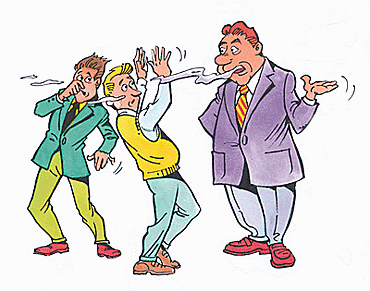hal-, hali-, -haled, -haling, -halant, -halent, -halation +
(Latin: breathe, breath; from halitus, "breath" and related to halare, "to breathe")
Don’t confuse this hal-, hali- unit meaning "breath, breathe" with another halio-, hali- unit which means "salt".
2. Exhalant artery or vessel, that which transfuses or conveys (blood, etc.) in minute quantities.
2. The action of emitting the breath; expiration; breathing out.
3. That which is exhaled; a mist, vapor, etc.; an emanation or effluvium, a scent.
2. To emit air or vapor.
3. To be given off or emitted.
4. To blow (something) forth or breathe (something) out.
5. To give, pass, or draw off in vapor.
6. To breathe, emit, or blow forth from within: "The chimney was exhaling dense smoke."
7. To breathe out (life, soul, words, a prayer, etc.).
8. To make an expiration; the opposite of inhale.
2. To give off a watery or other vapor.
When dealing with the problem of halitosis or with the halitosis patient, it is important to distinguish between "genuine halitosis" and "pseudo-halitosis".
"Genuine halitosis" can be verified when the breath malodor is an actual problem that can be easily diagnosed either by organoleptic or by physic-chemical processes. "Pseudo-halitosis" exists when the oral malodor does not exist, although the patient is convinced that he or she has it.
If, after successful treatment for either genuine halitosis or pseudo-halitosis, the patient still believes that he or she has halitosis, then the diagnosis is termed halitophobia.
This simple classification system includes corresponding treatment requirements and allows the clinician to differentiate between a pathological and a psychological condition.

A halitosis situation showing a condition of offensive, stale, or foul-smelling breath.
A medical term, first coined by the Listerine company in 1921, oral malodor (scientific term), breath odor; or the most common reference, to bad breath are terms used to describe obviously unpleasant odors exhaled while breathing.
Listerine is a brand name for antiseptic mouthwash, named after Joseph Lister (father of modern antiseptics). Its medicinal taste is palliated slightly by a sweet flavor. Its slogan is "Kills germs that cause bad breath", though halitosis can return after use, even if nothing "extra" is placed in the mouth. This happens because saliva washes away the listerine, allowing the body's natural bacteria to repopulate the area.
It was first formulated by Lister in 1879 as a surgical antiseptic and then by Dr. Joseph Lawrence and Jordan Wheat Lambert in 1879. It was given to dentists for oral care in 1895 and became the first over-the-counter mouthwash sold in the United States in 1914. Listerine was packaged in a glass bottle inside a cardboard tube for nearly 80 years before the first modifications were made to the brand.
Despite its Latin sounding heritage, halitosis is actually a combination of the Latin halitus, meaning "breath" and the Greek ending osis often used to describe a medical condition; such as, cirrhosis of the liver.
Halitosis has not been an affliction just of this "modern age"!
Although the term halitosis was introduced by Listerine in 1921; bad breath is not merely a modern affliction. It has been causing embarrassment for thousands of years. Records mentioning bad breath go back more than 3,000 years ago, as far back as 1550BC. In those days, the cause of bad breath was not known, but a mouthwash of wine and herbs was recommended as one way of solving the problem.
Today it is known that bacteria are the major cause of bad breath. Microbiologists estimate that there are around 400 different types of bacteria living in the mouth, with the total population possibly reaching into the hundreds of millions.
One new way to combat the causes of bad breath is the new Listerine PocketPaks. Made out of a thin starch based film the size of a stamp, the PocketPak strips dissolve instantly on the tongue. They were named by Time magazine as one of the "best inventions" of 2002.
Additional information which should help clarify halitosis problems
Halitosis is a general term used to describe an unpleasant or offensive odor emanating from the oral cavity. Although several non-oral sites have been related to oral malodor, including the upper and lower respiratory tracts, the gastrointestinal tract, and some diseases involving the kidneys or the liver, it is thought that around 90% of all bad breath odors emanate from the mouth itself. Oral halitosis is the specific term used to define halitosis with an origin within the oral cavity.
Transient bad breath is a very common temporary condition caused by such things as oral dryness, stress, hunger, eating certain foods; such as, garlic, onions, smoking, and poor oral care.
Causes of chronic bad breath may include smoking, poor dental hygiene, alcoholism, throat infection, dental infection, periodontitis (gum disease), sinusitis, lung infection, helminthiasis (intestinal parasitic infections), impacted teeth, diabetes, kidney failure, gastroesophageal reflux disorder (GERD), hormonal changes, and a wide variety of prescription drugs (especially when taken on a longterm basis). Regular dental flossing and brushing can reduce this problem for normal non-disease situations.
Other medical synonyms for this malodorous condition include: fetor oris, ozostomia, bromopnea, and stomatodysodia.
People are able to inhale oxygen and expel carbon dioxide from the lungs. Oxygen can only be drawn into the lungs and is therefore inexhalable.
2. A medicine, allergen, or other substance that is inhaled.
3. Any volatile substance, as nitrous oxide, butyl nitrite, toluene, gasoline, or paint thinner, capable of being inhaled, sometimes abused for its intoxicating effect.
4. An apparatus used for inhaling; a medicinal preparation for inhalation.
2. A preparation to be inhaled in the form of vapor.

